Market Size of Spain Prefab Wood Buildings Industry

| Study Period | 2020 - 2029 |
| Base Year For Estimation | 2023 |
| Forecast Data Period | 2024 - 2029 |
| Historical Data Period | 2020 - 2022 |
| CAGR | > 5.38 % |
| Market Concentration | Medium |
Major Players
*Disclaimer: Major Players sorted in no particular order |
Need a report that reflects how COVID-19 has impacted this market and its growth?
Spain Prefab Wood Buildings Market Analysis
The size of the Spain Prefab Wood Buildings Market is USD 1.02 billion in the current year and is anticipated to register a CAGR of over 5.38% during the forecast period. The market is driven by huge investments in prefabricated buildings. Furthermore, the market is driven by the advanced technology involved.
- The government expects to invest significant sums of money to address the affordable housing situation throughout the anticipated timeframe as the housing crisis intensifies. In its 20,000 Housing Plan, the Ministry of Transport, Mobility, and Urban Agenda seek to improve the availability of public housing for low-cost rent. There are currently 642,500 floors of public housing in Spain, which makes up only 2.5% of all housing. By 2030, the government hopes to raise this to 8% with this plan. To do this, the Ministry has invested about USD 62 million, which when added to the investments made by the Autonomous Communities and City Councils, totals USD 370 million.
- Demand growth has been attributed mostly to the housing market and the construction sector. Sales of wood house frames may be hampered by the availability of popular replacements like cement and steel. In the Spanish building sector, prefabricated homes are rising in popularity. In Spain, the number of businesses that specialize in modular housing has increased dramatically in recent years, and even huge developers have started to industrialize. If prefabricated timber construction is gaining popularity, it's for good reason. Aside from wood's unique properties (low carbon footprint, possibility of local short supply chain, etc.), prefabrication now means that constructing a timber building transitions from an on-site artisanal effort to an off-site industrial production with all of the benefits that entail. Factory-made production, with less risk than on-site construction, makes it easier to control costs and save time. Because the building is built in modules in a factory, residents living near the construction site often experience less noise and pollution. Furthermore, timber waste from construction sites (renovation, demolition) has a 75% recycling and energy recovery rate.
- To thrive in a dynamic environment, you must constantly experiment and think outside the box. In recent years, there has been an increase in creative problem-solving in the field of pre-engineered buildings (PEB). The fundamental steel framework for prefabricated steel buildings is made up of built-up sections, hot-rolled sections, and cold-formed components, while the roof and wall cladding are made up of single skin sheeting with extra insulation or insulated sandwich panels, respectively. These Pre-Engineered Steel Buildings' structural components can be customised to meet a variety of requirements. It has many advantages over more traditional structures for any low-rise construction. The various submarkets that comprise the international prefabricated building industry are defined by regional, structural, and functional specialisations.
